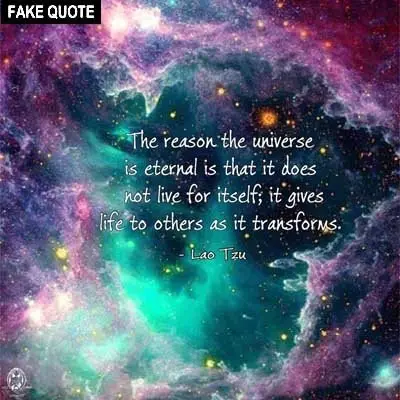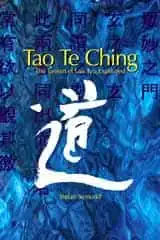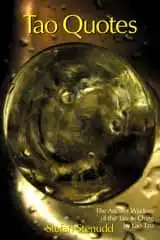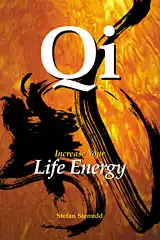|
Tao Te Ching
THE TAOISM OF LAO TZU
|
Fake Lao Tzu Quote"The reason why the universe..."
This is NOT a quote from Tao Te Ching:"The reason why the universe is eternal is that it does not live for itself; it gives life to others as it transforms."
The term 'universe' has sometimes been used in translations of Tao Te Ching, although it is a concept far from what was imagined in ancient China. A more adequate word for what Lao Tzu meant and perceived is 'world.' Also, the idea of the universe transforming is something closer to our conception of how it all works than what he might have imagined. He saw there was movement on earth as well as in the sky, but would not describe it as transformation. To him, the world had reached its form at the dawn of its emergence and would remain so forever. And who are the "others," given life by that transformation? The universe contains everyone and everything, There is no other. It would make more sense to say, for example, that the movements in the world create life within it. That is also how to approach something actually written in Tao Te Ching. Chapter 5 states (my version):
This somewhat elaborate quote would most likely have an origin, either an odd version of Tao Te Ching or a text commenting it. I have not been able to trace it in either. The closest semblance to the quote is in a Tao Te Ching version by Jerry O. Dalton from 1993 (page 16 in the 1996 edition):
The earliest book I have found with the exact quote is The Celestial Fortune Cookie: An Astrological Book of Days with Quotations for Every Sign from 2000, by Andrea Valeria. The quote was accredited to Lao Tzu and assigned to the Zodiac sign Sagittarius (page 426). Valeria used several quotes, mostly accrediting them to Lao Tzu but a few times to Tao Te Ching. It seems that she used different sources, maybe from the Internet in those rather early days of it. The Internet gives no clue to the origin of the quote. I have found no ascertained earlier appearance on the web than 2011. On Goodreads, the quote got its first like on June 8, 2011. Also on Facebook, the quote started to appear in 2011, the first two actually on January 8, which is before the first Goodreads like. Probably, the one got the other started. They all accredited Lao Tzu, but without giving any source. Since the quote had kind of a little boom on the web in 2011, the reason is probably not Valeria's book from 2000, nor the three books from 2007 and 2008 with the quote: Law of attraction by David Hooper (page 28), Java data mining by Hornick et al (page 451), and One reckless summer by Toni Blake (page 153). But the one to come next, From Eternity to Here: The Quest for the Ultimate Theory of Time from 2010, by Sean Carroll (page 82), was just in time to create some Internet noise the following year. On the other hand, Carroll and others might have found the quote on an older web site that I have not been able to find. Of the books mentioned above, only Hooper's gives a source to the quote: The Tao Te Ching of Lao Tzu from 2001, by Brian Browne Walker. Unfortunately, I have not found the quote in that source, nor did I find a 2001 edition. The book was initially published in 1995 and 1996, with a new edition in 2011. Well, 2001 can just be a reprint. None of the other editions contains the quote. If it is simply a typo, it has been persistent. Hooper's book has three Lao Tzu quotes, all given the same source, and I could find none of them there. Nor did I find it in Walker's version of Hua Hu Ching, falsely claimed to contain Lao Tzu's words. Instead, one is a Chuang Tzu quote in Arthur Waley's 1934 version of Tao Te Ching, discussed in the chapter To the mind that is still, and the other is from Poems of the Universe: Lao Tzu's Tao Te Ching from 2005, by Brian Donohue (page 40), which seems only to exist as a PDF file on the web. None of those books contains the quote examined here, though. Nor did I find any other book than Hooper's with all three quotes, so the origin of the quote examined here remains hidden.
Stefan Stenudd September 21, 2020.
More Fake Lao Tzu QuotesThere are many more fake Lao Tzu quotes examined on this website. Click the header to see a list of them.
Fake interview with the authorClick the header to read a "fake" interview with Stefan Stenudd, the author of Fake Lao Tzu Quotes.
About CookiesMy Other Websites:I Ching OnlineThe 64 hexagrams of the Chinese classic I Ching and what they mean in divination. Try it online for free.
Qi Energy ExercisesThe ancient Chinese life energy qi (chi) explained, with simple instructions on how to exercise it.
Life EnergyThe many ancient and modern life force beliefs all over the world explained and compared.
Taoismen på svenska
Other Books by Stefan StenuddClick the image to see the book at Amazon (paid link).
The Greek philosophers and what they thought about cosmology, myth, and the gods. |
 Tao Te Ching
Tao Te Ching Now it's a book, too!
Now it's a book, too! Tao Quotes
Tao Quotes Cosmos of the Ancients
Cosmos of the Ancients Qi — Increase Your Life Energy
Qi — Increase Your Life Energy Aikido Principles
Aikido Principles Life Energy Encyclopedia
Life Energy Encyclopedia Archetypes of Mythology
Archetypes of Mythology Stefan Stenudd
Stefan Stenudd